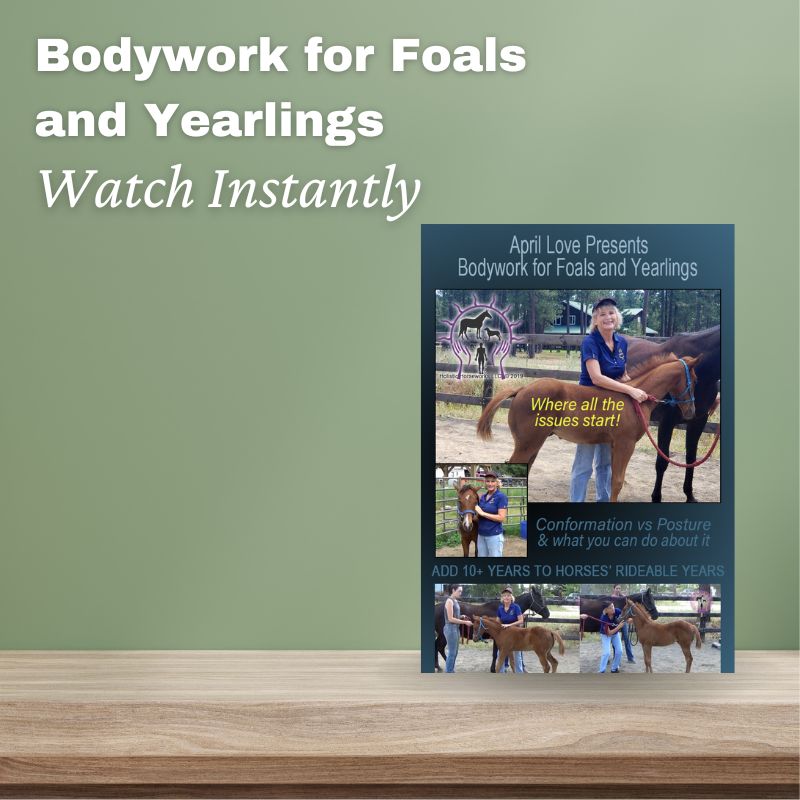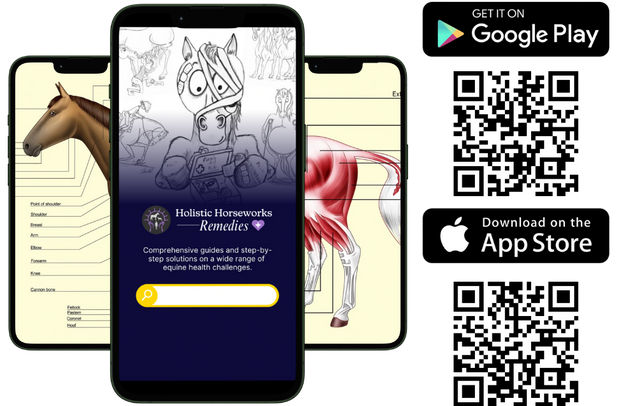Bodywork for Foals and Yearlings Watch Instantly
Original price was: $100.00.$70.00Current price is: $70.00.
This video is for the horse lovers that already have my other horse bodywork videos, that teach the beginning of how to start working on horses. This video was designed to show how the moves are different on very young horses and follow a different order.
We are very excited to bring you this BRAND NEW unique video on how to work on foals and yearlings. This is information that is being missed in the equine industry, as most horse owners do not start bodywork until a horse is in training, or showing signs of body or lameness issues. This video is for the horse lovers that already have my other horse bodywork videos, that teach the beginning of how to start working on horses. This video was designed to show how the moves are different on very young horses and follow a different order.
The misalignment of the first rib has deep rippling effects on the horse’s body, with additional consequences and we are finding this is starting much earlier than we thought. The problems can start as early as two months of age, as demonstrated with the first foal in our video. At two months old, first rib misalignment also affects the hoof on the same side, and how it lands and loads. It also causes the shoulder on the same side to not move freely or correctly. We discuss how the inside hoof bar is being pushed forward and how the inside heel is being crushed because of this misalignment under the left shoulder. This will determine which hoof is always out forward when eating off the ground and starts the high-low hoof syndrome. This will also lead to premature arthritic conditions, like sidebone and ringbone, as well as saddle fitting and body issues. This foal will not want to take his left lead canter easily and it will be mislabeled as a weakness or training issue.
On the second foal in our video, we work on a yearling with first rib misaligned on both sides. He is presenting Ewe neck and Roach back because of this. This yearling also exhibits both front hooves turning out and the hocks are too close together presenting as ‘cow hocked’. This issue is actually stemming from the Psoas muscle being too tight, pulling the hocks too close together. On a competition horse this would involve hock injections to keep them sound before age 7. This is not his true Conformation, this is Posture, developing from the horse not being able to move either shoulder correctly.
Our Equine industry would benefit greatly by learning this bodywork and starting our program much earlier. This will add 10+ years to horses’ rideable years.
No refunds are given on home study or watch instantly videos as digital materials are sent immediately at the time of purchase.
This video is for the horse lovers that already have my other horse bodywork videos, that teach the beginning of how to start working on horses. This video was designed to show how the moves are different on very young horses and follow a different order.
We are very excited to bring you this BRAND NEW unique video on how to work on foals and yearlings. This is information that is being missed in the equine industry, as most horse owners do not start bodywork until a horse is in training, or showing signs of body or lameness issues. This video is for the horse lovers that already have my other horse bodywork videos, that teach the beginning of how to start working on horses. This video was designed to show how the moves are different on very young horses and follow a different order.
The misalignment of the first rib has deep rippling effects on the horse’s body, with additional consequences and we are finding this is starting much earlier than we thought. The problems can start as early as two months of age, as demonstrated with the first foal in our video. At two months old, first rib misalignment also affects the hoof on the same side, and how it lands and loads. It also causes the shoulder on the same side to not move freely or correctly. We discuss how the inside hoof bar is being pushed forward and how the inside heel is being crushed because of this misalignment under the left shoulder. This will determine which hoof is always out forward when eating off the ground and starts the high-low hoof syndrome. This will also lead to premature arthritic conditions, like sidebone and ringbone, as well as saddle fitting and body issues. This foal will not want to take his left lead canter easily and it will be mislabeled as a weakness or training issue.




![Level 1 & Level 2 Home Study Bundle [NO DVD]](https://holistichorseworks.com/wp-content/uploads/2022/08/Level-1-and-Level-2-Home-Study-bundle-400x400.jpg)
![Canine Musculoskeletal Unwinding Watch Instantly & Home Study Course [NO DVD]](https://holistichorseworks.com/wp-content/uploads/2022/10/Holistic-Horseworks-Product-Mock-Ups-400x400.jpg)
![Level 1 "Equine Musculoskeletal Unwinding" Home Study [NO DVD]](https://holistichorseworks.com/wp-content/uploads/2022/02/Holistic-Horseworks-Product-Mock-Ups-400x400.jpg)
